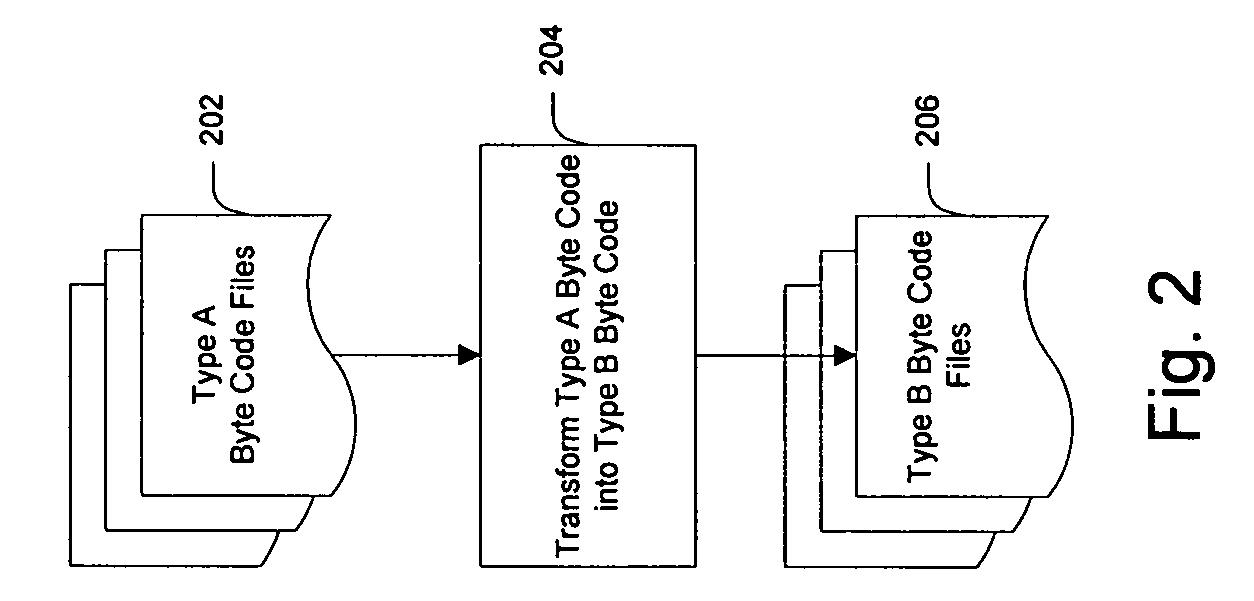[0013]In accordance with one embodiment of the present invention, byte code of a first type is converted into byte code of a second type. Byte code can comprise an intermediate code format that is typically lower-level than source code, but typically more abstract and machine-independent than object code. In an exemplary embodiment, Common Intermediate Language byte code is converted into SWF byte code. In one optional embodiment, source code of a first type is developed against a development library that contains references to byte code instructions of a second type. Source code can be compiled to byte code of a first type, which can be further converted into byte code of a second type. An advantage of this aspect of the invention is that the source code portions that were developed against the development library should, for the most part, effectively map to data and instructions of byte code of a second type because the development library already contains first byte code to second byte code mappings.
[0014]In one embodiment of the invention, byte code of a first type is converted into byte code of a second type by transforming table structures in the first byte code into table structures in the second byte code. Table structures include tables, arrays and indexes. Table structures contain entries for one or more data elements of the first byte code that refer to class definitions, members, types, methods, local variables, metadata, and / or arguments in the first byte code. Multiple source byte code table structures for classes and types, can, for example, be combined into a single global type array. One aspect of the invention permits classes to be represented by index reference instead of conventional class names. Referencing classes, methods and types by index can reduce the memory size and increase lookup speed, resulting in smaller and faster byte code of a second type.
[0016]In accordance with an embodiment of the invention, byte code of a first type is converted into one or more constituent data elements of a first byte code type. The data elements of a first type can be mapped to one or more data elements of a second type. For example, Common Intermediate language opcode data elements can be mapped to SWF action tag data elements. Where a direct mapping of first to second byte code language formats is not possible or desired, one or more second byte code data elements can be combined and mapped in order to mimic the layout or functionality of the first byte code data element. The mapped data elements of a second type can be assembled into byte code of a second type. Data elements can include any logical unit or grouping that comprises at least a portion of a software application. Data elements may include, for example, objects, instructions, metadata, variables, classes, functions, methods, or groupings thereof. Optionally, data elements may comprise remote “stub” functions, which contain instructions to remotely connect to a network resource. For example, remote data elements may execute a method on a network resource not available in the byte code of a second type, or may connect to information stores like a relational database for information. Optionally, byte code of a first type may be converted into an intermediate data structure, as described above. The intermediate data structure may then be parsed into data elements of a first type. According to another aspect of the invention, the step of mapping data elements of a first type to data elements of a second type may reference one or more mapping libraries. A mapping library can contain instructions for mapping specific data elements of a first type to one or more data elements of a second type. A mapping library may comprise data structures such as hash tables, lookup tables, and / or arrays to facilitate efficient lookup and mapping of data elements.
[0020]According to a further aspect of the invention, source byte code may be transformed into one or more byte code components of a second type. When a user requests byte code of a second type, the computer can return target second byte code by creating new byte code components and / or reusing existing byte code components, and assembling all of the necessary components into byte code of a second type. The second byte code components can be replaced individually to form new second byte code without requiring download or creation of all portions of the new second byte code.
[0021]In another embodiment of the present invention, an application plug-in performs the process of converting byte code of a first type into byte code of a second type. An application plug-in for byte code conversion may be used by applications including web servers, web browsers, media servers, and graphics applications. In another embodiment, an integrated development environment can utilize plug-ins or other computer instructions to perform byte code conversion. A developer can program source code, compile the source code to a first byte code, and test the first byte code software application. After the developer has sufficiently tested the first byte code application, the first byte code can be transformed into a second byte code by a byte code converter within the integrated development environment. The second byte code can be further tested by, for example, executing and displaying the second byte code in a display window of the integrated development environment, or executing the second byte code in a debugging environment. The byte code conversion process can seamlessly be inserted into the integrated development environment to allow a developer to easily develop in a programming language and development environment of a first type and produce byte code of a second type.
 Login to View More
Login to View More  Login to View More
Login to View More 


